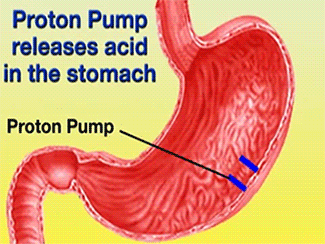User:Alisha, Deepa, Pamiz/Sandbox 1
From Proteopedia
Introduction
Esomeprazole is a Proton Pump Inhibitor (PPI) that binds to H+/K+-ATPase and inhibits the secretion of gastric acid from the parietal cells into the lumen of the stomach. Esomeprazole’s commercial brand name, Nexium, is used to treat Gastro-esophageal Reflux Disease (GERD), peptic and gastric ulcers, and Zollinger-Ellison syndrome. Ulcers caused by the bacterium Helicobacter pylori can be treated using Esomeprazole in conjunction with proper antibiotics.1 These result in gastric acid accumulation into the lumen of the stomach from the parietal cells.2 Gastric acid is released through the H+/K+-ATPase pump, which is the final step in acid release.2 Esomeprazole is an irreversible inhibitor of the pump.2
H+/K+-ATPase
Image:Canalicular Membrane.jpgThe H+/K+-ATPase pump is located within the cytoplasmic membrane of resting parietal cells (Figure 1); when activated, the ATPase is translocated to the canalicular membrane and begins to pump cytoplasmic H+ into the canalicular space, in exchange for extracellular K+ ions. The H+/K+-ATPase pump regulates the final step in the acid secretion pathway.3 Targeting this enzyme using PPIs is the most effective therapeutic control agent of gastric acid secretion.3 The H+/K+-ATPase pump, located within the cytoplasmic membrane of resting parietal cells, gets translocated upon activation to the canalicular membrane and pumps cytoplasmic H+ into the canalicular space, in exchange for extracellular K+ ions. It is a pro-drug that is protonated twice in the acidic environment of the parietal cell to form the active inhibitor, sulfenamide which forms disulfide bonds with Cys 813 and Cys 892 on the α subunit of the H+/K+-ATPase. Esomeprazole inhibits the final step in the secretion of gastric acid.
The structure of H+/K+-ATPase is an α,β-heterodimeric enzyme, where the catalytic site is present in the α subunit (Figure 2).7 Four transmembrane segments (TM4, TM5, TM6, and TM8) are located in the α subunit and contain the ion binding region of the enzyme.7 Three domains: A (actuator), N (nucleotide), and P (phosphorylation), are located within the α subunit.7 Binding of ions and ATP to these domains will induce movements in the membrane domain that catalyze ion displacement.7 A group of charged, polar, carboxylic acid amino acids are located in the middle of these transmembrane segments.7 A Lys 791 residue present in TM5 is responsible for providing specificity for H+ transport.7 This residue allows the transport of H+ to the lumen.7 The ammonium group of Lys moves into the H3O+ binding site, and displaces the bound hydronium.7 The movement of Lys occurs due to reorientation of TM4 and TM6, as the conformation changes from E1 to E2P and stabilizes H+ bonding of Lys791 (Scheme 1).7 The β subunit contains six or seven N-linked glycosylation sites, which directs the enzyme to the canalicular membrane.7
H+/K+-ATPase is part of the P-type ATPase enzyme family, and transports cations across the membrane.5 The pump goes against the H+ concentration gradient found in the stomach and is powered through ATP hydrolysis.5 The inorganic Pi produced drives a conformational change in the enzyme and allows release of H+ into the highly acidic environment.5 The enzyme catalyzes this reaction by changing conformation states between E1 and E2 (Scheme 1).6 The cytoplasm facing E1 conformational state has a high affinity for H+ ions, while the lumen facing E2 has a high affinity for K+ ions.6 The reaction begins when a hydronium ion binds to the enzyme on the cytoplasmic surface.6 MgATP will phosphorylate the enzyme at an Asp386 residue in a DKTG amino acid sequence to form the E1~Pi H+ intermediate.6 E1 undergoes a conformational change to form E2, where the ion site is exposed and H+ is released at a pH ~ 1.0.7 Extracellular K+ ions then bind to the same exposed region and the enzyme dephosphorylates.7 An occluded form of the enzyme (trapped) is formed once K+ ions bind; the enzyme de-occludes, reforms the E1 complex, and K+ is released.7

